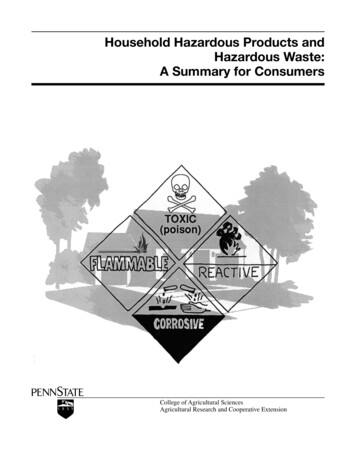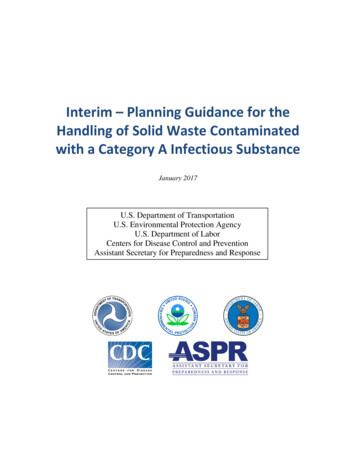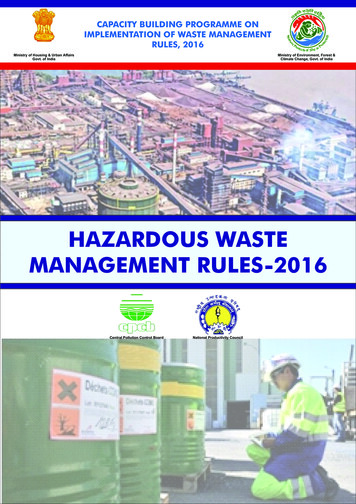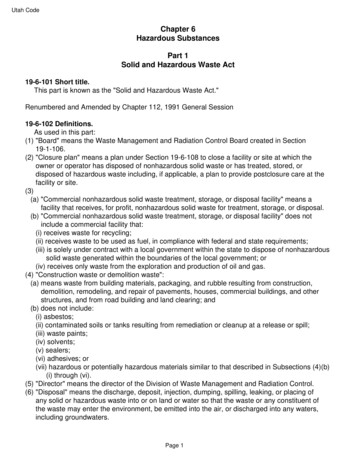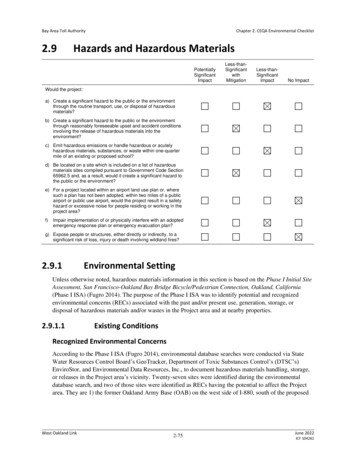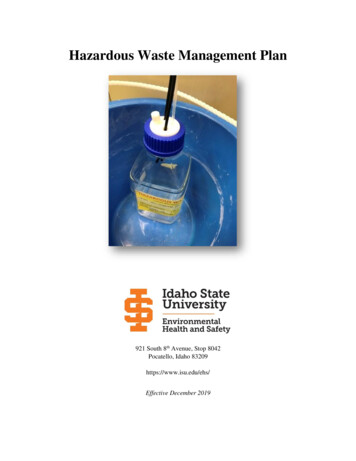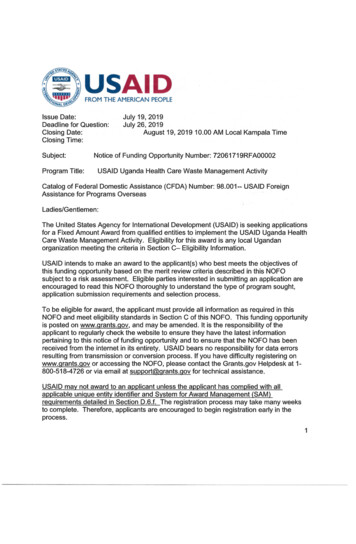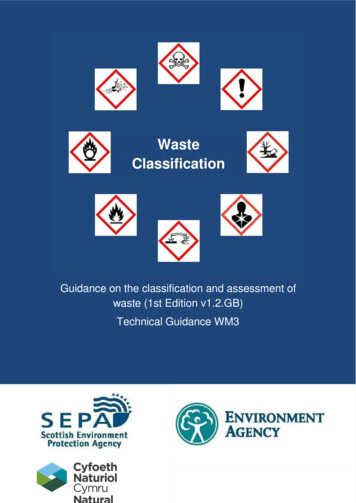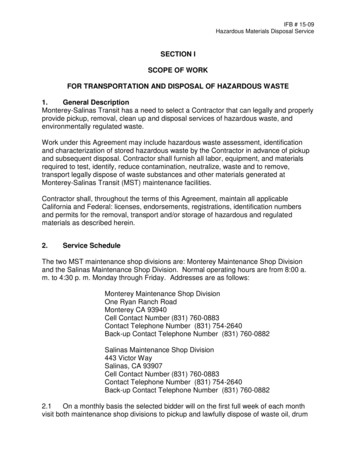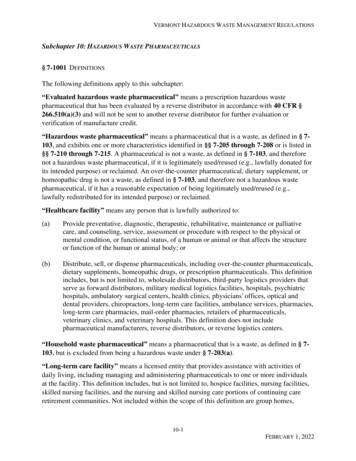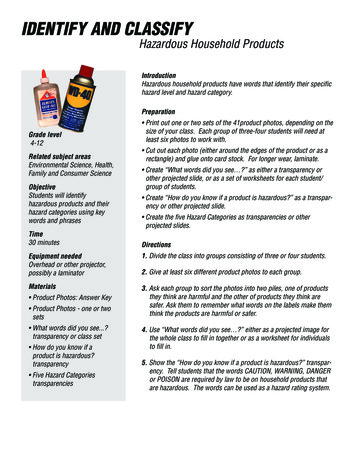
Transcription
Identify and ClassifyHazardous Household ProductsIntroductionHazardous household products have words that identify their specifichazard level and hazard category.PreparationGrade level4-12Related subject areasEnvironmental Science, Health,Family and Consumer ScienceObjectiveStudents will identifyhazardous products and theirhazard categories using keywords and phrasesTime30 minutes Print out one or two sets of the 41product photos, depending on thesize of your class. Each group of three-four students will need atleast six photos to work with. Cut out each photo (either around the edges of the product or as arectangle) and glue onto card stock. For longer wear, laminate. Create “What words did you see ?” as either a transparency orother projected slide, or as a set of worksheets for each student/group of students. Create “How do you know if a product is hazardous?” as a transparency or other projected slide. Create the five Hazard Categories as transparencies or otherprojected slides.DirectionsEquipment neededOverhead or other projector,possibly a laminator1. Divide the class into groups consisting of three or four students.Materials3. Ask each group to sort the photos into two piles, one of productsthey think are harmful and the other of products they think aresafer. Ask them to remember what words on the labels make themthink the products are harmful or safer. Product Photos: Answer Key Product Photos - one or twosets What words did you see.?transparency or class set How do you know if aproduct is hazardous?transparency Five Hazard Categoriestransparencies2. Give at least six different product photos to each group.4. Use “What words did you see ?” either as a projected image forthe whole class to fill in together or as a worksheet for individualsto fill in.5. Show the “How do you know if a product is hazardous?” transparency. Tell students that the words CAUTION, WARNING, DANGERor POISON are required by law to be on household products thatare hazardous. The words can be used as a hazard rating system.
6. Ask the groups to re-sort their product photos into three piles. Student results will vary depending onwhich images they have: Highest hazard pile (product must say DANGER or POISON) Moderate hazard pile (product must say CAUTION or WARNING) Safer pile (product does not say CAUTION, WARNING, DANGER or POISON)7. Show the Hazard Categories transparencies and review the terms and ideas.8. Ask each student to choose a hazardous product (one that says CAUTION, WARNING, DANGER or POISON) from their piles and determine which hazard category their hazardous product fits into. Is it flammable, corrosive, reactive, toxic or an irritant? Some products are hazardous in more than one way.After students know how their product is hazardous, this information can be shared with the rest of theclass. For example, have students stand at the front of the class, or raise their product image, if theirproduct is toxic. Continue through the rest of the hazard categories.9. As a check for understanding, have some students read their labels out loud to the rest of the class. Or,you might read labels from “real” products you have in the classroom. Have the rest of the class vote onwhether they think the product is hazardous or not, and if it is hazardous, what level of hazard it is.Alternative formats available.Call 206-263-3050 or 711 (TTY).file name: 0607hhwHHPdirections.indd wgab
Product PhotosName of productHazard levelAnswer KeyHazard Category *Name of productHazard levelHazard Category *3 in OneHousehold OilDToxicParson’sAmmoniaCIrritant, ToxicArm & HammerBaking SodaNo C-W-D-PNonePine-SolWIrritant, ToxicPrestoneAntifreezeWToxicRed Devil LyePCorrosive, ToxicRodda MasstoneEnamelDToxicRonsonol LighterFuelDFlammable, ToxicRubber CementDFlammableSoft ScrubCleanserCIrritantSpray-n-WashCIrritantSure FireUltimate RoachTrapNo C-W-D-PBon AmiCIrritantBrasso MetalPolishDFlammable,Irritant, ToxicBubblesNo strol BrakeFluidDToxicClorox BleachDCorrosiveComet CleanserCNot clear fromfront of labelCrayola CrayonsNo C-W-D-PIrritant, ToxicNoneCutexWFlammableDow Heavy DutyOven CleanerDCorrosive, ToxicElmer’s Glue-AllNo C-W-D-PNoneFuture WaxCIrritantGasolineDFlammable, ToxicHeinz CiderVinegarNo C-W-D-PNoneHolidayHousehold InsectFoggerCNot clear fromfront of labelJasco Paint andEpoxy RemoverDIrritant, ToxicJohnson LemonPledgeCFlammableK2r Spot-lifterDFlammable,Irritant, ToxicKrylon Interior/Exterior PaintDFlammable,Irritant, ToxicLiquid-PlumrDCorrosive, ToxicMill Creek CastileSoapPara Moth BallsNo C-W-D-PCNoneNot clear fromfront of labelNoneTideCIrritant, ToxicTilexWIrritantTurpentineDFlammable, ToxicUltra SheenNo C-W-D-PNoneUltra-Pure Candle& Lamp OilDFlammable, ToxicWD-40DFlammable, Toxic* That can be seen on the front of the product photo. Moreinformation is often available elsewhere on a real product.These food items can be used to create safer alternatives tohazardous household products. See activites in this series:Toxic-free Bingo and Concentration Game.
Notes:Always read the front and back label of the actual product you are considering using or buying. These photosare only a practice set.These photos show only the front label. Actual products could have much more information on the back label,including additional hazard categories. To simplify the learning, we categorized the product photos only by theinformation available on the front labels.Companies change their formulas frequently, and thus, the hazard level or category may also change. As thesephotos become dated, they may not represent the current formulation of a product.What is “reactive”? There are many different kinds of hazardous reactions. In a home, the most commonreactive products are chlorine bleach and ammonia. If these products are accidentally mixed, they produce toxicgases. Products containing chlorine bleach or ammonia are “reactive” and will say on the back label “do not mixwith other household products to avoid hazardous gases.” This information is often not stated on the front labeland your students will not have access to that information with this photo set.Product Photos created by:Alternative formats available.Call 206-263-3050 or 711 (TTY).file name: 0607hhwPHOTOSkey.indd wgabPublication number: SCH-CUR-PRODUCT-1 (8/06)
ED.DANGER: HARMFUL IF SWALLOWREN.KEEP OUT OF REACH OF CHILD
DANGER: KEEP OUT OF REACHOF CHILDREN. INJURES EYES,SKIN, AND MUCOUS MEMBRANESON CONTACT. HARMFUL IFSWALLOWED.
KEEP OUT OF REACH OF CHILDREN.WARNING. EYE IRRITANT. USE ONLYIN WELL VENTILATED AREAS. SEE BACK OFLABEL FOR ADDITIONAL PRECAUTIONS.
CAUTION: EYE IRRITANT. READCAUTIONS ON BACK LABEL CAREFULLY.
What words did you seeon the household products?1.C2.W3.D4.P5.Keep6.Fatal if7.If swallowed, call8.h9.h10. flfile name: 0607hhwWORDS.indd wgab
How do you knowif a product is hazardous?SaferDoes not haveCAUTION, WARNING,DANGER or POISONon the labelModerateHazardCAUTION or WARNINGHighestHazardDANGER or POISONfile name: 0607hhwHOWKNOW.ai wgab
TOXIC:Can cause injury or death if swallowed, inhaled,or absorbed through the skinPhrase to look for: Harmful or fatal if swallowedRATPOISONWEEDandFEED
CORROSIVE:Can wear away materials or burn living tissueby chemical actionPhrases to look for: Causes chemical burns; Injurious toskin and eyesToiletBowlCleaner
FLAMMABLE/COMBUSTIBLE:Can catch fire at relatively low temperaturesPAINTTHINNERPhrase to look for: Keep from heat or flame
REACTIVE:Can create a toxic gas if mixed with other productsPhrase to look for: Do not mix.LO LSCAOIP MEHCOMORTH anerAB leC
IRRITANT:Can cause inflammation of living tissue on contactPhrase to look for: Eye and skin irritantREHAS PW AHIS SODfile name: 0608hazCATEG.indd wgab
other projected slide, or as a set of worksheets for each student/ group of students. Create "How do you know if a product is hazardous?" as a transpar-ency or other projected slide. Create the five Hazard Categories as transparencies or other projected slides. Directions 1. Divide the class into groups consisting of three or four .
